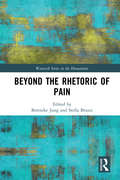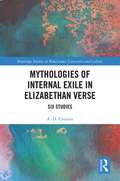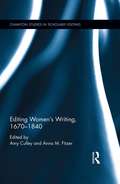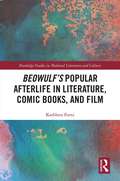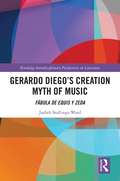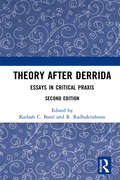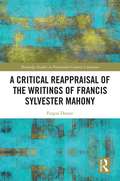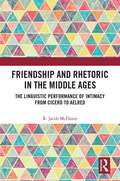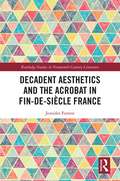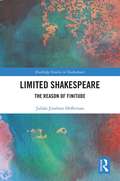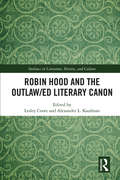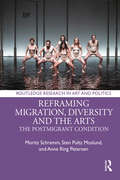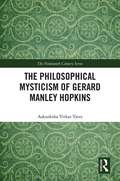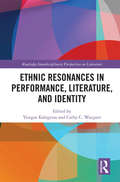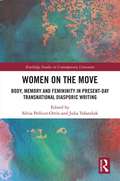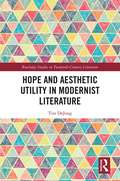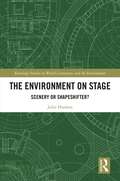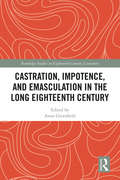- Table View
- List View
A Companion to the History of the Book (Blackwell Companions to Literature and Culture)
by Simon Eliot Jonathan RoseFrom the early Sumerian clay tablet through to the emergence of the electronic text, this Companion provides a continuous and coherent account of the history of the book. Makes use of illustrative examples and case studies of well-known texts Written by a group of expert contributors Covers topical debates, such as the nature of censorship and the future of the book
The Ethical Vision of George Eliot: Communion and Difference (Among the Victorians and Modernists)
by Thomas AlbrechtThe Ethical Vision of George Eliot is one of the first monographs devoted entirely to the ethical thought of George Eliot, a profoundly significant, influential figure not only in nineteenth-century English and European literature, nineteenth-century women’s writing, the history of the novel, and Victorian intellectual culture, but also in the field of literary ethics. Ethics are a predominant theme in Eliot’s fictional and non-fictional writings. Her ethical insights and ideas are a defining element of her greatness as an artist and novelist. Through meticulous close readings of Eliot’s fiction, essays, and letters, The Ethical Vision of George Eliot presents an original, complex definition of her ethical vision as she developed it over the course of her career. It examines major novels like Adam Bede, Middlemarch, and Daniel Deronda; many of Eliot’s most significant essays; and devotes two entire chapters to Eliot’s final book Impressions of Theophrastus Such, an idiosyncratic collection of character sketches that Eliot scholars have heretofore generally overlooked or ignored. The Ethical Vision of George Eliot demonstrates that Eliot defined her ethical vision alternately in terms of revealing and strengthening a fundamental human communion that links us to other persons, however different and remote from ourselves; and in terms of recognizing and respecting the otherness of other persons, and of the universe more generally, from ourselves. Over the course of her career, Eliot increasingly transitions from the former towards the latter imperative, but she also considerably complicates her conception of otherness, and of what it means to be ethically responsible to it.
Beyond the Rhetoric of Pain (Warwick Series in the Humanities)
by Stella Bruzzi Nike JungBeyond the Rhetoric of Pain presents a fresh, interdisciplinary approach to the current research on pain from a variety of scholarly angles within Literature, Film and Media, Game Studies, Art History, Hispanic Studies, Memory Studies, Anthropology, Sociology, Philosophy, and Law. Through the combination of these perspectives, this volume goes beyond the existing structures within and across these disciplines framing new concepts of pain in attitude, practice, language, and ethics of response to pain. Comprised of fourteen unique essays, Beyond the Rhetoric of Pain maintains a common thread of analysis using a historical and cultural lens to explore the rhetoric of pain. Considering various methodologies, this volume questions the ethical, social and political demands pain makes upon those who feel, watch or speak it. Arranged to move from historical cases and relevance of pain in history towards the contemporary movement, topics include pain as a social figure, rhetorical tool, artistic metaphor, and political representation in jurisprudence.
Mythologies of Internal Exile in Elizabethan Verse: Six Studies (Routledge Studies in Renaissance Literature and Culture)
by A.D. CousinsWriters of the English Renaissance, like their European contemporaries, frequently reflect on the phenomenon of exile—an experience that forces the individual to establish a new personal identity in an alien environment. Although there has been much commentary on this phenomenon as represented in English Renaissance literature, there has been nothing written at length about its counterpart, namely, internal exile: marginalization, or estrangement, within the homeland. This volume considers internal exile as a simultaneously twofold experience. It studies estrangement from one’s society and, correlatively, from one’s normative sense of self. In doing so, it focuses initially on the sonnet sequences by Sidney, Spenser, and Shakespeare (which is to say, the problematics of romance); then it examines the verse satires of Donne, Hall, and Marston (likewise, the problematics of anti-romance). This book argues that the authors of these major texts create mythologies—via the myths of (and accumulated mythographies about) Cupid, satyrs, and Proteus—through which to reflect on the doubleness of exile within one’s own community. These mythologies, at times accompanied by theologies, of alienation suggest that internal exile is a fluid and complex experience demanding multifarious reinterpretation of the incongruously expatriate self. The monograph thus establishes a new framework for understanding texts at once diverse yet central to the Elizabethan literary achievement.
Editing Women's Writing, 1670-1840 (Chawton Studies in Scholarly Editing)
by Amy Culley Anna M. FitzerThis edited volume is the first to reflect on the theory and practice of editing women’s writing of the 18th century. The list of contributors includes experts on the fiction, drama, poetry, life-writing, diaries and correspondence of familiar and lesser known women, including Jane Austen, Delarivier Manley, Eliza Haywood and Mary Robinson. Contributions examine the demands of editing female authors more familiar to a wider readership such as Elizabeth Montagu, Mary Robinson and Helen Maria Williams, as well as the challenges and opportunities presented by the recovery of authors such as Sarah Green, Charlotte Bury and Alicia LeFanu. The interpretative possibilities of editing works published anonymously and pseudonymously are considered across a range of genres. Collectively these discussions examine the interrelation of editing and textual criticism and show how new editions might transform understandings not only of the woman writer and women’s literary history, but also of our own editorial practice.
Beowulf's Popular Afterlife in Literature, Comic Books, and Film
by Kathleen ForniBeowulf's presence on the popular cultural radar has increased in the past two decades, coincident with cultural crisis and change. Why? By way of a fusion of cultural studies, adaptation theory, and monster theory, Beowulf's Popular Afterlife examines a wide range of Anglo-American retellings and appropriations found in literary texts, comic books, and film. The most remarkable feature of popular adaptations of the poem is that its monsters, frequently victims of organized militarism, male aggression, or social injustice, are provided with strong motives for their retaliatory brutality. Popular adaptations invert the heroic ideology of the poem, and monsters are not only created by powerful men but are projections of their own pathological behavior. At the same time there is no question that the monsters created by human malfeasance must be eradicated.
Gerardo Diego’s Creation Myth of Music: Fábula de Equis y Zeda (Routledge Interdisciplinary Perspectives on Literature)
by Judith Stallings-WardSince its publication nearly eight decades ago, the consensus among scholars about Fábula de Equis y Zeda, by the Spanish poet Gerardo Diego (1896-1987) remains unchanged: Fábula is an enigmatic avant-garde curiosity. It seems to rob the reader of the reason necessary to interpret it, even as it lures him or her ineluctably to the task; nevertheless, the present study makes the case that this work is, in fact, not inaccessible, and that what the anhelante arquitecto, intended with his masterpiece was a creation myth that explains the evolution of music in his day. This monograph unlocks the fullness of the poem´s meaning sourced in music’s mythical consciousness and expressed in a poetic idiom that replicates aesthetic concepts and cubist strategies of form embraced by the neoclassical composers Bartok, Falla, Ravel, and Stravinsky.
Theory after Derrida: Essays in Critical Praxis
by R. Radhakrishnan Kailash C. BaralA critical anthology that re-examines Jacques Derrida’s thought by way of theory and praxis, this volume reflects on his striking legacy and the future of theory. Among contemporary thinkers, Derrida challenges not only our ways of thinking but also hitherto methods of inquiry. This book captures how Derrida renovates and re-energises philosophy by questioning the fundamental assumptions of Western philosophical thought. By doing so, he exposes the intricate lie behind binaries, such as speech/writing, nature/culture, male/female, black/white, literature/criticism, etc., which have continued to shape our worldview, where a hegemonic centre is always already in place dominating or marginalising the ‘other’. A significant contribution to literary theory, this book explores not only the status of Derrida’s contribution as a critical thinker but also the status of critical theory as such in the contemporary milieu. The central question that it asks is whether we should dismiss Derrida as a thinker who espoused an extreme form of relativism, bordering on nihilism, or has he something fundamental to contribute to the future of theory. Could it be that deconstruction is not destruction but a possibility that casts doubts on whether the present can have faith in future? This second edition includes a new Postscript and addresses some important concerns of our times, such as religious practice, art and aesthetics, translation, sociology of philosophy, and democracy. Scholars and researchers of English literature, philosophy, sociology and cultural studies will find this work particularly interesting.
A Critical Reappraisal of the Writings of Francis Sylvester Mahony (Routledge Studies in Nineteenth Century Literature)
by Fergus DunneThis book resituates Francis Sylvester Mahony in an early nineteenth-century literary-historical context, counteracting the efforts of twentieth-century literary historians to obscure his contribution to the emergence of a distinctive Irish Catholic fiction in English. This volume re-explores his ambivalent role as a Catholic unionist contributor to the progressive Tory London periodical, Fraser’s Magazine, examining his use of translation to map out an alternative literary aesthetic of the peripheries. The book also traces the development of his political thinking in his Italian journalism for Charles Dickens’ Daily News, in which he responded to the events of the Famine by finding common cause with Young Ireland, and looks afresh at his final incarnation as a British Liberal commentator on Irish and European affairs for the Globe newspaper. More broadly, the book seeks to re-evaluate Mahony’s cosmopolitan writings in relation to the multifaceted, transnational perspectives on Irish, British, and European affairs presented in his essays and journalism.
Sir Thomas More V2 (The Pickering Masters)
by Tom Duggett Tim FulfordIn 1829 Robert Southey published a book of his imaginary conversations with the original Utopian: Sir Thomas More; or Colloquies on the Progress and Prospects of Society. The product of almost two decades of social and political engagement, Colloquies is Southey’s most important late prose work, and a key text of late 'Lake School' Romanticism. It is Southey’s own Espriella’s Letters (1807) reimagined as a dialogue of tory and radical selves; Coleridge’s Church and State (1830) cast in historical dramatic form. Over a series of wide-ranging conversations between the Ghost of More and his own Spanish alter-ego, ‘Montesinos’, Southey develops a richly detailed panorama of British history since the 1530s - from the Reformation to Catholic Emancipation. Exploring issues of religious toleration, urban poverty, and constitutional reform, and mixing the genres of dialogue, commonplace book, and picturesque guide, the Colloquies became a source of challenge and inspiration for important Victorian writers including Macaulay, Ruskin, Pugin, and Carlyle.
Beowulf's Popular Afterlife in Literature, Comic Books, and Film
by Kathleen ForniBeowulf's presence on the popular cultural radar has increased in the past two decades, coincident with cultural crisis and change. Why? By way of a fusion of cultural studies, adaptation theory, and monster theory, Beowulf's Popular Afterlife examines a wide range of Anglo-American retellings and appropriations found in literary texts, comic books, and film. The most remarkable feature of popular adaptations of the poem is that its monsters, frequently victims of organized militarism, male aggression, or social injustice, are provided with strong motives for their retaliatory brutality. Popular adaptations invert the heroic ideology of the poem, and monsters are not only created by powerful men but are projections of their own pathological behavior. At the same time there is no question that the monsters created by human malfeasance must be eradicated.
Friendship and Rhetoric in the Middle Ages: The Linguistic Performance of Intimacy from Cicero to Aelred
by R. Jacob McDonieFriendship and Rhetoric in the Middle Ages: The Linguistic Performance of Intimacy from Cicero to Aelred covers approximately 1,200 years of literature. This is a book on "medieval literature" that foregrounds language as the agent for cultivating medieval friendship (from the first century BC to c. 1160 AD) in oratorical, ecclesiastical, monastic, and erotic contexts. Taking a different approach than many works in this area, which search for the lived experience of friends behind language, this book stands apart in looking at friendship's enactment through rhetorical language among classical and medieval authors.
Decadent Aesthetics and the Acrobat in French Fin de siècle (Routledge Studies in Nineteenth Century Literature)
by Jennifer ForrestIn his discussion of clowns in nineteenth-century French painting from Jean-Léon Gérôme’s 1857 La Sortie du bal masqué to Georges Rouault, art historian Francis Haskell wondered why they are so sad. The myth of the sad clown as an allegory for the unappreciated artist found echoes in the work of literary counterparts like Charles Baudelaire and his "Vieux saltimbanque" who seeks in vain a responsive public. For some, the attraction of the acrobatic clown for the creative imagination may have been his ability to embody the plight of the artist: these artistes generally led an ambulatory and uncertain existence. Other artists and writers, however, particularly the Decadents, perceived in the circus acrobat – including the acrobatic clown – a conceptual and performative tool for liberating their points of view from the prison-house of aesthetic convention. If authors’ protagonists were themselves sometimes failures, their aesthetic innovations often produced exhilarating artistic triumphs. Among the works examined in this study are the circus posters of Jules Chéret, Thomas Couture’s Pierrot and Harlequin paintings, Honoré Daumier’s saltimbanque paintings, Edgar Degas’s Miss Lala au Cirque Fernando, Édouard Manet’s Un bar au Folies-Bergère, the pantomimes of the Hanlon-Lees troupe, and novels, short stories, and poems by Théodore de Banville, Edmond de Goncourt, J. K. Huysmans, Gustave Kahn, Jules Laforgue, Catulle Mendès, Octave Mirbeau, Jean Richepin, Edouard Rod, and Marcel Schwob.
Limited Shakespeare: The Reason of Finitude (Routledge Studies in Shakespeare)
by Julián Jiménez HeffernanShakespeare’s poetic-dramatic worlds are inescapably limited. There is always, in his poems and plays, a force (a contingent drive, a pre-textual undertow, a rational-critical momentum, an ironic stance, the deflections of error) coercing plot and meaning to their end. By examining the work of limits in the sonnets and in five of his plays, this book seeks not only to highlight the poet’s steadfast commitment to critical rationality. It also aims to plead a case of hermeneutic continence. Present-day appraisals of Shakespeare’s world-making and meaning-projecting potential are often overruled by a neo-romantic and phenomenological celebration of plenty. This pre-critical tendency unwittingly obtains epistemic legitimation from philosophical quarters inspired by Alain Badiou’s derisive rejection of "the pathos of finitude". But finitude is much more than a modish, neo-existentialist, watchword. It is what is left of ontology when reason is done. And cool reason was already at work before Kant. In accounting for the way in which Shakespeare places limits to life (Romeo and Juliet), to experience (The Tempest), to love (the Sonnets), to time (Macbeth), to the world (Hamlet) and to knowledge (Othello), Limited Shakespeare: The Reason of Finitude aims to underscore the deeply mediated dimension of Shakespearean experience, always over-determined by the twin forces of contingency and textual determinism, and his meta-rational and virtually ironic taste for irrational, accidental, and error-driven limits (bonds, bounds, deaths).
Robin Hood and the Outlaw/ed Literary Canon (Outlaws in Literature, History, and Culture)
by Lesley Coote Alexander L. KaufmanThis cutting-edge volume demonstrates both the literary quality and the socio-economic importance of works on "the matter of the greenwood" over a long chronological period. These include drama texts, prose literature and novels (among them, children's literature), and poetry. Whilst some of these are anonymous, others are by acknowledged canonical writers such as William Shakespeare, Ben Jonson, and John Keats. The editors and the contributors argue that it is vitally important to include Robin Hood texts in the canon of English literary works, because of the high quality of many of these texts, and because of their significance in the development of English literature.
Reframing Migration, Diversity and the Arts: The Postmigrant Condition (Routledge Research in Art and Politics)
by Moritz Schramm Sten Pultz Moslund Anne Ring Petersen Mirjam Gebauer Hans Christian Post Sabrina Vitting-Seerup Frauke WiegandThis book offers a compelling study of contemporary developments in European migration studies and the representation of migration in the arts and cultural institutions. It introduces scholars and students to the new concept of ‘postmigration’, offering a review of the origin of the concept (in Berlin) and how it has taken on a variety of meanings and works in different ways within different national, cultural and disciplinary contexts. The authors explore postmigrant theory in relation to the visual arts, theater, film and literature as well as the representation of migration and cultural diversity in cultural institutions, offering case studies of postmigrant analyses of contemporary works of art from Europe (mainly Denmark, Germany and Great Britain).
Mythologies of Internal Exile in Elizabethan Verse: Six Studies (Routledge Studies in Renaissance Literature and Culture)
by A.D. CousinsWriters of the English Renaissance, like their European contemporaries, frequently reflect on the phenomenon of exile—an experience that forces the individual to establish a new personal identity in an alien environment. Although there has been much commentary on this phenomenon as represented in English Renaissance literature, there has been nothing written at length about its counterpart, namely, internal exile: marginalization, or estrangement, within the homeland. This volume considers internal exile as a simultaneously twofold experience. It studies estrangement from one’s society and, correlatively, from one’s normative sense of self. In doing so, it focuses initially on the sonnet sequences by Sidney, Spenser, and Shakespeare (which is to say, the problematics of romance); then it examines the verse satires of Donne, Hall, and Marston (likewise, the problematics of anti-romance). This book argues that the authors of these major texts create mythologies—via the myths of (and accumulated mythographies about) Cupid, satyrs, and Proteus—through which to reflect on the doubleness of exile within one’s own community. These mythologies, at times accompanied by theologies, of alienation suggest that internal exile is a fluid and complex experience demanding multifarious reinterpretation of the incongruously expatriate self. The monograph thus establishes a new framework for understanding texts at once diverse yet central to the Elizabethan literary achievement.
Beyond the Rhetoric of Pain (Warwick Series in the Humanities)
by Berenike Jung Stella BruzziBeyond the Rhetoric of Pain presents a fresh, interdisciplinary approach to the current research on pain from a variety of scholarly angles within Literature, Film and Media, Game Studies, Art History, Hispanic Studies, Memory Studies, Anthropology, Sociology, Philosophy, and Law. Through the combination of these perspectives, this volume goes beyond the existing structures within and across these disciplines framing new concepts of pain in attitude, practice, language, and ethics of response to pain. Comprised of fourteen unique essays, Beyond the Rhetoric of Pain maintains a common thread of analysis using a historical and cultural lens to explore the rhetoric of pain. Considering various methodologies, this volume questions the ethical, social and political demands pain makes upon those who feel, watch or speak it. Arranged to move from historical cases and relevance of pain in history towards the contemporary movement, topics include pain as a social figure, rhetorical tool, artistic metaphor, and political representation in jurisprudence.
The Philosophical Mysticism of Gerard Manley Hopkins (The Nineteenth Century Series)
by Aakanksha Virkar YatesThrough the lens of Hopkins's 'masterwork', The Philosophical Mysticism of Gerard Manley Hopkins readdresses Hopkins's frequently overlooked mysticism as an interior narrative within his corpus. Drawing on a range of religious, literary and visual traditions from Augustine's Confessions to the seventeenth-century spiritual emblem, this book demonstrates the ways in which the Wreck deliberately constructs and conceals a mystical and contemplative narrative. Typology and allegory are some of the important hermeneutic tools used in this re-reading of Hopkins, relating the poet to the discursive tradition surrounding the Old Testament Song of Songs, the philosophical theology of the Greek Fathers, and, perhaps most intriguingly, the meditative and visual tradition of the baroque heart-emblem. On the centenary of the publication of Hopkins’s poems, this book places the writer firmly within a mystical tradition, necessitating a fundamental reconsideration of the legacy of this major Victorian poet.
Ethnic Resonances in Performance, Literature, and Identity (Routledge Interdisciplinary Perspectives on Literature)
by Yiorgos Kalogeras Cathy C. WaegnerThis volume seeks to weave applications of the dynamic concept of resonance to ethnic studies. Resonance refers to the ever broadening, multidirectional effects of movement or action, a concept significant for many disciplines. The individual chapters exchange the concept of static "intertextuality" for that of interactive "resonance," which encourages consideration of the mutual and processual influences among readings, paradigms, and social engagement in cultural analysis. International scholars of literary and cultural studies, linguistics, history, politics, or ethno-environmental studies contribute their work in this volume. Each chapter examines a specific ethnic phenomenon in terms of relevant literature, lived experience and theoretical approaches, or historical intervention, relating the given case study to parameters of resonance. The book offers dialogic transnational interchange, a play of eclectic ethnic voices, inquiries, perspectives, and differences. The studies in this interdisciplinary volume show that – through resonant engagement with(in) and between works – literary production can both enhance and disturb cultural narratives of ethnicity.
Women on the Move: Body, Memory and Femininity in Present-Day Transnational Diasporic Writing
by Silvia Pellicer-Ortín Julia TofantshukWomen on the Move: Body, Memory and Feminity in Present-day Transnational Diasporic Writing explores the role of women in the current globailized era as active migrants. the authors have brought together a collection of essays from scholars in diaspora, migration and gender studies to take a look at the female experince of migration and globalization by covering topics such as vulnerability, empowerment, trauma, identity, memory, violence and gender contruction, which will continue to shape contemporary literature and the culture at large.
Hope and Aesthetic Utility in Modernist Literature (Routledge Studies in Twentieth-Century Literature)
by Tim DeJong"Hope" and "modernism" are two words that are not commonly linked. Moving from much-discussed negative affects to positive forms of feeling, Hope and Aesthetic Utility in Modernist Literature argues that they should be. This book contends that much of modernist writing and thought reveals a deeply held confidence about the future, one premised on the social power of art itself. In chapters ranging across a diverse array of canonical writers – Henry James, D.W. Griffith, H.D., Melvin Tolson, and Samuel Beckett – this text locates in their works an optimism linked by a common faith in the necessity of artistic practice for cultural survival. In this way, the famously self-attentive nature of modernism becomes a means, for its central thinkers and artists, of reflecting on what DeJong calls aesthetic utility: the unpredictable, ungovernable capacity of the work of art to shape the future even while envisioning it.
Limited Shakespeare: The Reason of Finitude (Routledge Studies in Shakespeare)
by Julián Jiménez HeffernanShakespeare’s poetic-dramatic worlds are inescapably limited. There is always, in his poems and plays, a force (a contingent drive, a pre-textual undertow, a rational-critical momentum, an ironic stance, the deflections of error) coercing plot and meaning to their end. By examining the work of limits in the sonnets and in five of his plays, this book seeks not only to highlight the poet’s steadfast commitment to critical rationality. It also aims to plead a case of hermeneutic continence. Present-day appraisals of Shakespeare’s world-making and meaning-projecting potential are often overruled by a neo-romantic and phenomenological celebration of plenty. This pre-critical tendency unwittingly obtains epistemic legitimation from philosophical quarters inspired by Alain Badiou’s derisive rejection of "the pathos of finitude". But finitude is much more than a modish, neo-existentialist, watchword. It is what is left of ontology when reason is done. And cool reason was already at work before Kant. In accounting for the way in which Shakespeare places limits to life (Romeo and Juliet), to experience (The Tempest), to love (the Sonnets), to time (Macbeth), to the world (Hamlet) and to knowledge (Othello), Limited Shakespeare: The Reason of Finitude aims to underscore the deeply mediated dimension of Shakespearean experience, always over-determined by the twin forces of contingency and textual determinism, and his meta-rational and virtually ironic taste for irrational, accidental, and error-driven limits (bonds, bounds, deaths).
The Environment on Stage: Scenery or Shapeshifter? (Routledge Studies in World Literatures and the Environment)
by Julie HudsonThe Environment on Stage: Scenery or Shapeshifter? investigates a pertinent voice of theatrical performance within the production and reception of ecotheatre. Theatre ecologies, unavoidably enmeshed in the environment, describe the system of sometimes perverse feedback loops running through theatrical events, productions, performances and installations. This volume applies an ecoaware spectatorial lens to explore live theatre as a living ecosystem in a literal sense. The vibrant chemistry between production and reception, and the spiralling ideas and emotions this generates in some conditions, are unavoidably driven by flows of matter and energy, thus, by the natural environment, even when human perspectives seem to dominate. The Environment on Stage is an intentionally eclectic mix of observation, close reading and qualitative research, undertaken with the aim of exploring ecocritical ideas embedded in ecotheatre from a range of perspectives. Individual chapters identify productions, performances and installations in which the environment is palpably present on stage, as it is in natural disasters such as floods, storms, famine, conflict and climate change. These themes and others are explored in the context of site-specificity, subversive spectators, frugal modes of narrative, the shifting ‘stuff’ of theatre productions, and imaginative substitutions. Ecotheatre is nothing less than vibrant matter that lets the environment speak for itself
Castration, Impotence, and Emasculation in the Long Eighteenth Century (Routledge Studies in Eighteenth-Century Literature)
by Anne Leah GreenfieldThis essay collection examines one of the most fearsome, fascinating, and hotly-discussed topics of the long eighteenth century: masculinity compromised. During this timespan, there was hardly a literary or artistic genre that did not feature unmanning regularly and prominently: from harrowing tales of castrations in medical treatises, to emasculated husbands in stage comedies, to sympathetic and powerful eunuchs in prose fiction, to glorious operatic performances by castrati in Italy, to humorous depictions in caricature and satirical paintings, to fearsome descriptions of Eastern eunuchs in travel narratives, to foolish and impotent old men who became a mainstay in drama. Not only does this unprecedented study of unmanning (in all of its varied forms) illustrate the sheer prevalence of a trope that featured prominently across literary and artistic genres, but it also demonstrates the ways diminished masculinity reflected some of the most strongly-held anxieties, interests, and values of eighteenth-century Britons.


